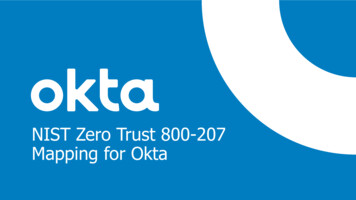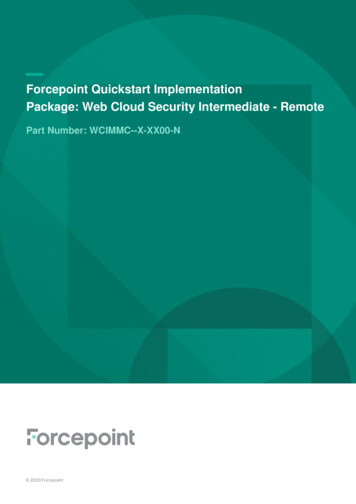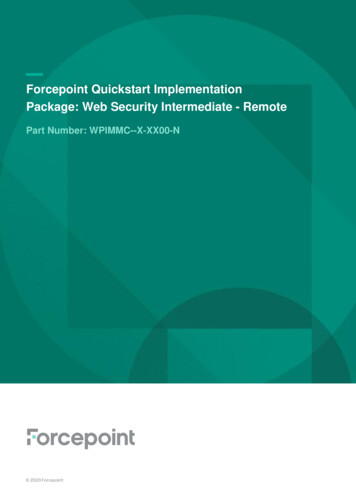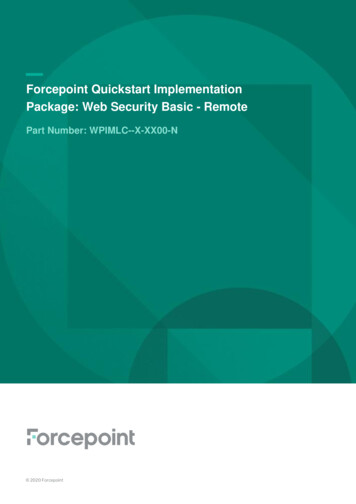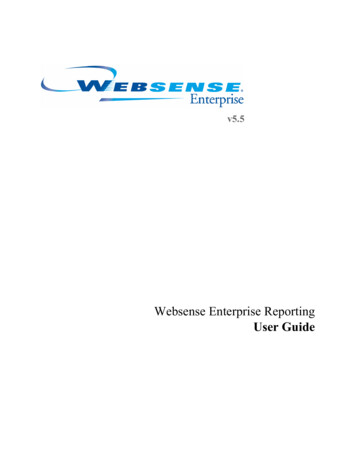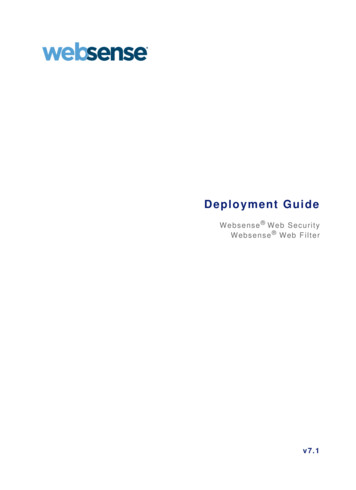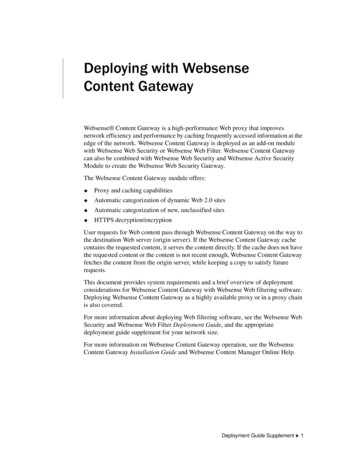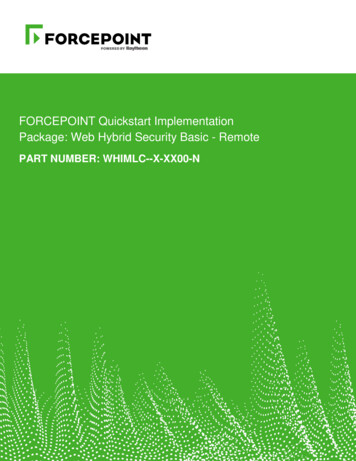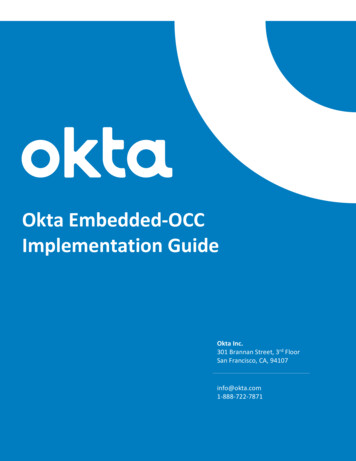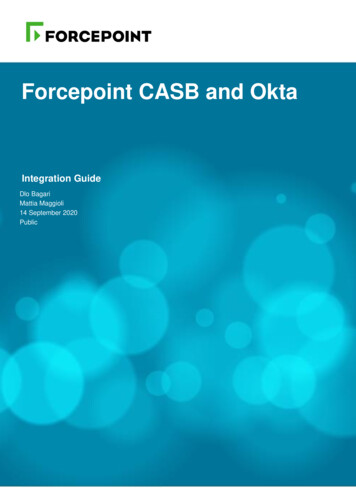
Transcription
Forcepoint CASB and OktaIntegration GuideDlo BagariMattia Maggioli14 September 2020Public
Forcepoint CASB and Okta – Integration GuideSummary . 2Caveats . 2Implementation .3Step 1 – Create an API token in Okta .4Step 2 – Groups into Okta .5Step 3 – Configure the Risk Level Manager .8Step 4 – Installing Risk Level Manager.9Troubleshooting . 10VersionDateAuthorNotes0.107 January 2020Dlo BagariFirst draft0.213 January 2020Mattia MaggioliReview0.315 January 2020Dlo BagariAdded auto active session termination0.420 January 2020Dlo BagariUpdated package name0.504 February 2020Dlo BagariUpdated mapping logic for risk score ranges0.606 March 2020Mattia MaggioliUpdated supported OS and Okta API0.723 March 2020Neelima RaiAdded troubleshooting chapter0.814 September 2020Mattia MaggioliMinor updatesPublicforcepoint.com 1
Forcepoint CASB and Okta – Integration GuideSummaryThis guide provides step by step instructions to configure Forcepoint CASB and Okta to pass risk scoresand to adjust authentication policies accordingly.The code and instructions provided enable system administrators to automatically: Provide the risk level calculated by Forcepoint CASB for each user managed by Okta Adjust authentication policies applied by Okta to users based on their risk level Terminate active sessions in order to force re-authentication upon increase of risk score Terminate active sessions and suspend account of Okta users whose risk score reached a giventhreshold, to prevent any further actionThis interoperability enables risk-adaptive authentication policies for Okta users based on theintelligence provided by Forcepoint CASB.A description of the workflow between the components involved in this POC is depicted in this diagram:CaveatsThese implementation instructions are tested with the following product versions: Forcepoint CASB – 2019 R2 Okta 2020.03.0Publicforcepoint.com 2
Forcepoint CASB and Okta – Integration GuideThis interoperability uses the “Risk Score” of Forcepoint CASB for Okta users in order to change thelogin policies for the Okta users.The following activities are out of the scope of this document and therefore left to the systemadministrator, as part of ordinary maintenance procedures to be put in place within the existinginfrastructure: configuration of appropriate hygiene procedures to handle logs produced during any step of thesolution workflow monitoring of the scripts, services and applications involved in the solutionImplementationThe solution described in this chapter requires the following files available at this link:https://frcpnt.com/casb-okta-latest fp-casb-exporter-okta-v1.tar.gzThe fp-casb-exporter-okta-v1.tar.gz contains all files necessary to setup and run all the servicesused by the Risk Level Manager to accomplish the interoperability between Forcepoint CASB andOkta: Okta CASB Service: extracts risk score from Forcepoint CASB for all users. Finds maximum riskscore of each user across multiple accounts and orchestrates change of group membership forall accounts managed by Okta, so that risk-adaptive authentication polices are applied by Okta. Okta CASB Timer Service: monitors Okta CASB Service and runs it on a scheduled basisWe suggest deploying the Risk Level Manager on a CentOS 7.x or 8.x machine with at least 2 GBRAM and 20 GB of storage, the instructions provided in this document are based on this operatingsystem and the following packages Python 3 Python modules: requests, PyYAML The software packages and related dependencies are automatically installed by the okta-casbinstaller.sh script provided inside the fp-casb-exporter-okta-v1.tar.gz file, which will executethe following commands as part of the deployment script of the Risk Level Manager:Publicforcepoint.com 3
Forcepoint CASB and Okta – Integration Guidesudo yum install -y do yum install -y python36u python36u-libs python36u-devel python36u-pipsudo pip3 install PyYAMLsudo pip3 install requestsThe machine hosting the Risk Level Manager will be referenced in the rest of this document with thename “RLM-host”.Step 1 – Create an API token in OktaIn order to connect and perform operations inside Okta, the Risk Level Manager requires a valid token.API tokens have the same permissions of the user who creates them, and the Risk Level Managerrequires administrative access in order to perform its tasks.It is recommended to create a new user with the minimum roles necessary to issue tokens and toperform the operations of the Risk Level Manager. Only the following Administrator Roles arenecessary: Read Only Administrator API Access Management AdministratorOnce a user is created, follow these steps to issue a new token under that user:1.2.3.4.5.Sign into your Okta organization using the newly created administratorMake sure you are using the Classic UI: you can check this setting in the top left cornerof the Okta page, right above the Okta logoGo to Security API and click on the Tokens tabClick Create Token, name your token and click Create TokenSave this Token Value in a secure location, as this is the only time it can be viewed.Publicforcepoint.com 4
Forcepoint CASB and Okta – Integration GuideStep 2 – Groups into OktaAuthentication steps applied to users authenticating through Okta are defined as Sign On rulesconfigured into Groups, for example: Source IP of the user authenticating Okta Verify (either code or push notification) SMS authentication Voice Call Authentication External MFA apps Security questionA user authenticating through Okta will be challenged according to the policies configured via the user’sgroup membership. To do this, create user groups to map the desired risk level policies to users.A typical risk score mapping, group and policy configuration are as follows: Users with risk score in range 100 to 250 are mapped to risk level 1 group with standardPublicforcepoint.com 5
Forcepoint CASB and Okta – Integration Guideauthentication policies (e.g. push notification) Users with risk score in range 251 to 500 are mapped to risk level 2 group which has morecomplex authentication policies (e.g. push notification and SMS authentication) Users with risk score equal and greater than 501 are mapped to suspend policy (it is apredefined policy in Risk Level Manager). Suspend users can't log in to Okta. Their group andapp assignments are retained.If multiple user groups with existing policies are already configured into Okta, then skip this part and goto Step 3.In the following example, we create a new user group and assign a multifactor policy based on SMSAuthentication:1. Go to Directory Groups, click on Add Group2. Name the new group and add a description, then click Add Group to create it3. Go to Security Multifactor, click SMS Authentication and then the drop-down menu sothat the new factor is set to ActivePublicforcepoint.com 6
Forcepoint CASB and Okta – Integration Guide4. Switch to the Factor Enrollment tab and click Add Multifactor Policy5. Name your policy and enter a description, assign it to the group created for this risk level6. Set the “SMS Authentication” to Required using the drop-down menu, set to Disabled anyother factor not assigned to this policy. Once done click Create Policy.7. Now click on the newly created policy and click Add Rule8. Name the rule and set the conditions for the multi-factor enrollmentMulti-factor challenges must be enrolled in order to be applied to any further authentication attempt. It isrecommended for all users to be pre-enrolled for any authentication method that may be required.Alternatively, steps 7 and 8 above can also be used to configure multi-factor enrollment when the user ischallenged for the first time. In this case it is suggested to configure the rule to only allow first timeenrollment if the user is connecting from trusted networks (e.g. configure a network Zone in Networksso that trusted corporate IP ranges are known to Okta, and use the trusted Zone in a rule which allowsmulti-factor enrollment only when users authenticate from the corporate networks).Repeat the steps above to create additional groups with the desired authentication policies to bemapped to a risk score range provided by Forcepoint CASB.Publicforcepoint.com 7
Forcepoint CASB and Okta – Integration GuideStep 3 – Configure the Risk Level ManagerAll parameters required by the Risk Level Manager to operate its services are stored in a single filecalled settings.yml:The following table provides a description of every parameter in the settings.yml file:Requires tobe changedParameterDescriptionokta tokenAPI token created in Okta as described in step 1 of thisdocumentOrganization URL for Okta, used for authenticating users andfor API calls by the Risk Level Manager and its servicesYEScasb login passwordForcepoint CASB instance passwordYEScasb login nameForcepoint CASB instance login nameYESThe callback function used by CASB UI for processing logincredentials against the backend services of CASBNOThe URL which allows users to download a .CSV file with thelist of users and their risk scoreDirectory where the Risk Level Manager is stored, by default/var/okta casbNOokta organization urlcasb ligin form action urlcasb users csv urlapplication directoryPublicYESNOforcepoint.com 8
Forcepoint CASB and Okta – Integration Guidelogs locationsdatabase pathDirectory where the Risk Level Manager logs are stored, bydefault /var/okta casb/logsDirectory where the Risk Level Manager database is stored, bydefault /var/okta casbMaps risk score ranges to Okta groups.NONOe.g.To map the risk score from 100 to 150 to an Okta group named“Risk level 1”100-150: Risk level 1risk score mapYESTo consider all scores above a given value use the signe.g.To assign risk scores equal and greater than 500 to thepredefined policy suspend use500 : suspendterminate user session after policy changeinterval timeIf set to true, terminates the user's active sessions uponchange of risk score range, so that user is forced to log inagain according to the authentication policies assigned to thenew risk score range / Okta group.NOTo control how frequently risk score is downloaded from CASBand processed. Time is expressed in minutes.NOStep 4 – Installing Risk Level ManagerTo set up the Risk Level Manager, proceed as follows:1. Login via SSH to the RLM-host and copy the fp-casb-exporter-okta-v1.tar.gz file into /rootfolder of the machine that will host the Risk Level Manager2. Decompress the file using the command tar -zxvf fp-casb-exporter-okta-v1.tar.gz3. Go into the /root/ fp-casb-exporter-okta-v1 folder and edit settings.yml to update the valueof the required parameters, change only the entries that are required to be changedaccording to the table in step 34. Make sure installer.sh is executable using the command sudo chmod a x okta-casbinstaller.sh5. Install the Risk Level Manager using the command sudo ./okta-casb-installer.shThe installer script will read settings.yml, move the services to the application directoryand create two systemd services. The file setings.yml will then be moved toPublicforcepoint.com 9
Forcepoint CASB and Okta – Integration Guideapplication directory: do not change the location of the file.6. Once the installation is completed, reboot the machine7. After reboot is completed, log into the machine and verify two services of the Risk LevelManager are running with the commandsystemctl list-units grep okta casbIf all services are running, the Risk Level Manager is operating normally and the interoperability betweenForcepoint CASB and Okta is completed: the Risk Level Manager will automatically download users riskscore from Forcepoint CASB and group memberships into Okta will be adjusted dynamically as soon asthe risk score changes into a different range.TroubleshootingFollow these steps to identify issues impacting the normal operation of the integration described in thisdocument.Validate the prerequisitesMake sure the prerequisites described in the Summary chapter are all satisfied: Check the versions of Forcepoint CASB and Okta in use are listed as compatibleForcepoint CASB – 2019 R2Okta 2020.03.0 Verify the integration component correctly operates on a clean CentOS 7.x or CentOS 8.xmachine (server version only) with at least 2 GB RAM and 20 GB of storage User must be root to run the okta-casb-installer.sh Check the user can download the file with the below commands:yum install wgetwget --content-disposition https://frcpnt.com/casb-okta-latestCheck network connectivityMake sure firewalls or other security appliances are not impacting the network connectivity necessaryfor the operation of all components involved into this integration: Check Risk Level Manager has network connectivity to CASB: execute the following commandon the RLM-host machine:Publicforcepoint.com 10
Forcepoint CASB and Okta – Integration Guideping -c 2 example-casb.urlreplacing the example URL/IP address with the current one used. Once done check the result issimilar to below:PING example-casb.url (10.10.120.12) 56(84) bytes of data.64 bytes from 10.10.120.12 (10.10.120.12): icmp seq 1 ttl 128 time 179 ms64 bytes from 10.10.120.12 (10.10.120.12): icmp seq 1 ttl 128 time 181 msCheck dependencies are installedMake sure the software dependencies needed by the components involved into this integration areinstalled: Check all dependencies are installed: execute the following command on RLM-host:python3 --version; pip3 --version; pip3 list 2 /dev/null grep -e requests -e PyYAMLNote: The software versions may change depending on latest upgrades. Check the last few lines after installation completion are similar to below:Check all components are configured and running properlyMake sure the products and services involved into this integration are configured as expected and theyare running: Check all components are configured and running as expected: Execute the below command:systemctl list-units grep okta casband check the result is similar to below:Publicforcepoint.com 11
Forcepoint CASB and Okta – Integration Guide 2020 ForcepointForcepoint and the FORCEPOINT logo are trademarks of Forcepoint.All other trademarks used in this document are the property of their respective owners.Publicforcepoint.com 12
Forcepoint CASB and Okta - Integration Guide 9forcepoint.com Public logs_locations Directory where the Risk Level Manager logs are stored, by default /var/okta_casb/logs NO database_path Directory where the Risk Level Manager database is stored, by default /var/okta_casb NO risk_score_map Maps risk score ranges to Okta groups. e.g.
